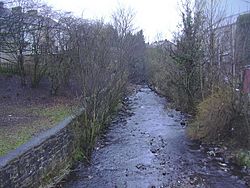River Hyndburn facts for kids
Quick facts for kids Hyndburn |
|
|---|---|

River Hyndburn at Church Bridge.
|
|
| Country | England |
| Physical characteristics | |
| Main source | Goodshaw Hill, Rossendale (as Woodnook Water) |
| River mouth | Hyndburn Brook, south of Dunkenhalgh. |
The River Hyndburn is a small river in Lancashire, England. It starts as a stream called Woodnook Water on Goodshaw Hill. As it flows, it passes through places like Stone Fold and Rising Bridge. When it reaches Baxenden, other small streams join it.
The river then flows into the Woodnook area of Accrington. Near St James Church, another stream called Broad Oak Water joins it. From this point, the river officially becomes the River Hyndburn.
The River Hyndburn travels north through Accrington town centre. It picks up Pleck Brook and then turns west. It flows under a large bridge that carries the East Lancashire railway line. The river then continues its journey to a town called Church.
After Church, the river turns north again. It soon meets Hyndburn Brook just before going under the M65 motorway bridge. This is south of Dunkenhalgh. The Hyndburn Brook then continues past Clayton-le-Moors and Great Harwood. Finally, it flows into the River Calder. Today, many parts of the river and its smaller streams flow underground through special tunnels called culverts. The area of Lancashire called Hyndburn is actually named after this river!
What does Hyndburn mean?
The name "Hyndburn" comes from an old language called Old English. The word burna means "stream." So, the second part of the name means "stream."
The first part of the name is a bit of a mystery. It might come from the Old English word hyldre, which means "elder-tree." Or it could be from the word hynd, meaning "hind" (a female deer). It might even come from an old personal name like Helþor.
Two of the streams that form the River Hyndburn are in an old area called Henheads. People think this area was named because the Hyndburn river was often called the Henburn in the past.
Rivers that join the Hyndburn
Many smaller streams and brooks flow into the River Hyndburn. These are called its tributaries. Here are some of them:
- Antley Syke
- Pleck Brook
- Broad Oak Water
- Warmden Brook
- Tag Clough
- Laund Clough
- Warmden Brook
- Woodnook Water
- Tom Dale Clough
- Luddington Clough
River wildlife and nature
There's a project happening to help fish and eels move more easily along the River Hyndburn. This project aims to allow fish like salmon, trout, and eels to travel further upstream.
In 2017, a special fish bypass was built. This helps fish get around a tall, 4-metre (13 ft) high wall called a weir. This weir is from the 1800s and is located at the Oakenshaw Print Works on Hyndburn Brook. In June 2019, similar work started further upstream at the Dunkenhalgh weir near Rishton.
On July 11, 2018, two areas, Woodnook Vale and Peel Park, were officially made local nature reserves. This means they are protected areas for nature. They became the two largest nature reserves in Lancashire.
- Woodnook Vale covers about 3.5 kilometres (2.2 mi) of Woodnook Water, south of Accrington. It also includes Rothwell Heights.
- Peel Park is east of Accrington. It includes the old mill ponds that used to supply water to the Plantation Mill print works. These ponds now feed Pleck Brook.

